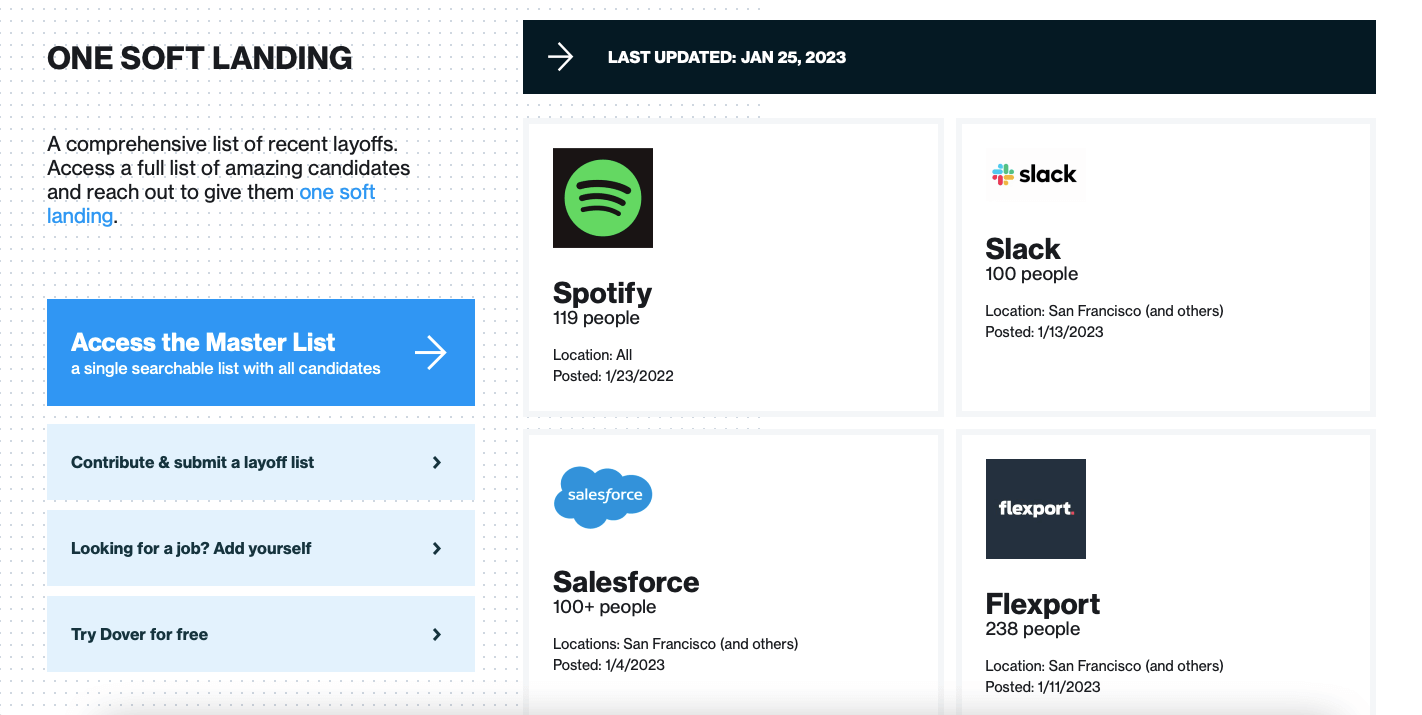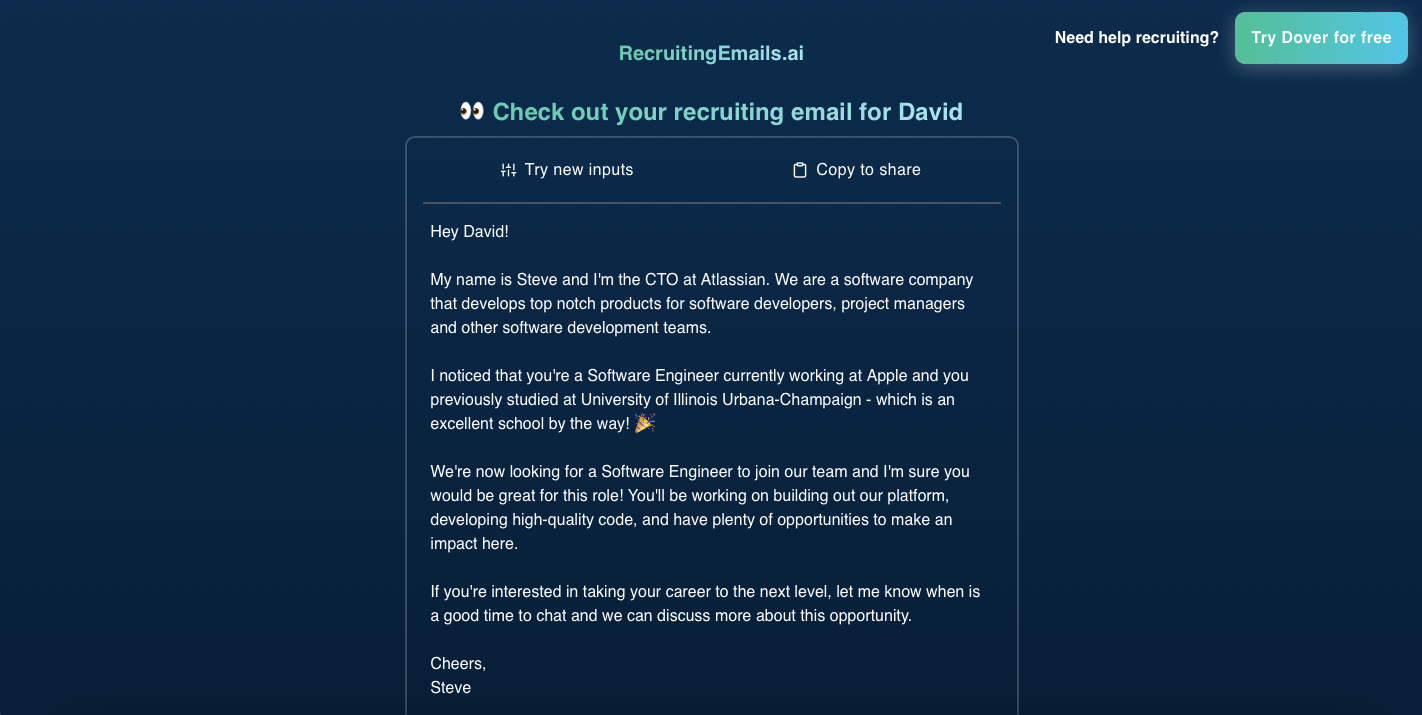Despite layoffs and the economic downturn, the talent market remains competitive. Software engineers are flooded with emails, LinkedIn messages, and phone calls. That’s why companies need to find a way to stand out so they can attract the right talent.
In this text version of the December 15th webinar, we talk about the optimal channel for finding the perfect talent, the fundamental inbound and outbound recruiting frameworks, and how to improve the candidate experience. We also discuss the major drivers of layoffs in the tech sector and whether the job market is going to change in 2023.
The webinar speaker is Max Kolysh, founder and CEO of Dover, a recruiting automation platform that helps companies streamline recruiting and provide a better candidate experience.
Featured speaker: Max Kolysh, founder and CEO of Dover
Moderator: Yura Riphyak, co-founder and CEO of YouTeam
Table of Contents
On layoffs at tech companies
Yura:
I’d like to start with the biggest issue that’s bothering our audience right now. We are all following the news and restlessly updating our Twitter feed, and what we are seeing is a waterfall of layoffs. According to recent data, more than 100,000 people have been laid off by tech companies. The market is different than it was a few months ago, and I’m curious to know what you think about it. Is it still a candidate market?
Max:
I’ll start with a shameless plug. Our service, called onesoftlanding.com tracks all kinds of layoffs in real time. The website contains a list of people who have been laid off so that other companies can interview and hire them.
Things started to slow down six to eight months ago. First, there were a lot of layoffs among growth-stage, Series B companies that were tightening their belts. Then, about three months ago, larger companies like Plaid and Airtable started pretty substantial layoffs, 20 to 30 percent of employees.
It’s unclear what is going to happen next. Tech companies are going to have the hardest time because tech had such a massive boom during COVID and in the following years. There may be layoffs in other areas as well. Most people are saying we’re either on the brink of a recession or already in one, and I think hiring will slow down for a while.
There is another effect that is happening — the U.S. Fed’s interest rate hikes. Also, there are many other safer asset classes than venture capital or tech. And you know that tech companies just have to return a lot more capital or have to be better risk-adjusted investments today compared to a year ago or three years ago. A lot of money is fleeing, that’s why you’re seeing a big drop in tech growth stocks — up to 80 percent.
Many of these companies are in a tough spot — they are slowing down hiring because there is no guarantee that they will have the next round of funding. And when you’re not focused on growth, when it’s not clear if the next round of funding is coming, you’re on a much stricter timeline, and layoffs are on the horizon.
In general, Fed rates have a direct effect on layoffs, and I think that’s the dominant effect — until rates change, I don’t see things changing much in tech.
One last thing worth looking at is valuations. Although we are seeing a significant pullback, we are still at 2018-2019 levels. Money is still being invested, the situation isn’t extremely grim, it’s just that when the market went gangbusters, we quickly got used to the good stuff.
Now, a lot of companies are in an unhealthy position as a consequence of how much they are hiring. All of the VCs I’ve talked to give their companies the same advice — cut spending as much as possible, hire for necessary roles only, and make the most out of the team you have.
Yura:
That makes sense. And yet many companies keep hiring. We’ve seen this list published by Pragmatic Engineer, and it keeps getting updated. Last I saw, it had about 1,300 companies on it.
Max:
Yes, most of the customers who use our platform are either planning for future hiring needs or are currently hiring — from passively searching and sort of looking around to being very active and really eager to fill a position.
It depends a lot on what stage of the life cycle the company is at. In large companies — I’m talking about the tech sector, from Series C to pre-IPO — the turnover rate is 25 to 50 percent a year. These companies need to hire to stay in place in terms of headcount simply because there’s constant attrition. So they are closing certain specialty roles and filling key positions where people left at an earlier stage.
As for seed and Series A companies, a lot of them raised money, say, one or two years ago, and they’re trying to build a product and get the product to market. These companies still need people, and they obviously get a pretty big incremental gain from every person they hire.


How Dover simplifies the recruiting process
Yura:
It seems to me that those companies that are still able to hire more people and have enough money or good financial results have a unique opportunity right now. There’s a lot of talent on the market with experience at large tech companies. And that window of opportunity is closing because people are looking for a job for two to three months.
Let’s talk a little bit about that. I’d like to start with Dover, what your company does, and what makes you different in attracting top talent.
Max:
We call ourselves a recruiting orchestration platform. The brief vision that we all saw when we started the company about four years ago is that recruiting is obviously a people business — you need to be good at pitching people. That seems like an obvious, superficial answer when you look at it from the outside. However, when you find yourself inside a recruiting department, or a startup trying to figure out recruiting for the first time, you find that, actually, a ton of the work is operations and processing.
Recruiting is 20% strategy and 80% operational work, and some of that work is pretty tedious, like using ten different tools, a bunch of data sources, constant scheduling, and rescheduling. So we said, hey, the job of a recruiter, hiring manager, or founder shouldn’t be doing all those tedious things. Let companies focus on what they do best, which is strategy, and we’ll create a recruiting operations platform for them.
What’s more, smaller companies treat us like a white-label recruiting department — they get lots of smart defaults, workflow automation, candidate management, and can get an expert advisor who they can consider as a head of talent.
Yura:
Yes, it’s really amazing. You’re like a super app that offers complete automation of the recruiting process.
Inbound vs. Outbound vs. Referrals: The best strategy for hiring great talent
Yura:
Now let’s move on to the topic of attracting the best talent in the market. What do you think about the optimal channels for finding the best developers?
Max:
There are three ways to attract candidates — inbound, outbound, and referrals. Referrals are probably the most commonly used by companies in the earliest stages. You can convince friends from your network to be interviewed, so they are more likely to answer the call. The problem is that this method doesn’t scale — you’ll usually be able to find candidates from your network once or twice.
Inbound is basically posting a job on a job board and waiting for a candidate to come to you. The problem here is we have no control over who comes in — you get more or less random people. Often you’re interviewing two to five percent of the people that are coming inbound, so candidates get the negative feeling that they applied to all these companies and didn’t even get a callback. On the flip side, companies get tons of candidates, and many of them are just irrelevant.
Finally, outbound recruiting is probably the newest strategy, where a company actively reaches out to candidates through GitHub, LinkedIn, or other social networks. The main advantage is that you can reach out to anyone — the whole world is your candidate pool. The downside is that it’s time-consuming compared to five minutes to post a job description.
With outbound recruiting, you have to pre-screen candidates and come up with personalized emails. Chances are, out of 100 candidates, no more than ten will respond to the email because they are all in a very selective field.
So here are the three recruiting channels. Going back to your question about which one is better, it depends on the role:
Outbound is typically good for niche roles — if there are very few people in the world who are even qualified for the position, you usually use this method. The CEO can approach people personally, starting not even with an interview but with a couple of coffees. The more senior the position is, the more you focus on outbound.
Inbound is a checkbox to make sure you don’t miss anyone who is actively interested in your company. It is also very good for entry-level positions.
You have to experiment with this over time, budget different amounts for different strategies, and see what works to maximize ROI. (At Dover, we do all this for you; the product is designed to help you with recruiting experiments). Try using a combination of these strategies, focusing on your company brand and what makes you different from the competition.
Browse 500+ Dev Teams Available for Hire
How to reach the best engineers
Yura:
Yes, you have to remember that this is a really competitive market. Great talent is flooded with a lot of emails, LinkedIn messages, and phone calls. Companies really need to find a way to stand out. Do you have success stories from your clients about how they managed to cut through that noise to get to the candidate?
Max:
We have a lot of examples from our clients because Dover makes it a priority to attract the best talent on the market and gives smart hints that help companies build trust. For example, if a candidate graduated from a university whose alumni work for the company, that might be a point of contact in a cold outreach. We also take into account the layoff list to get even more results.
The second detail — and I’ll link this to a question from the online chat about how many emails that companies send to passive candidates from LinkedIn get a response — is that the best you’ll get for a remote engineering position is a 6-7% interest rate. In addition, the longer you search for a candidate, the faster this rate goes down because you are exhausting the people who are most relevant.


What is a good candidate experience?
Yura:
We started talking about looking at things from the candidate’s point of view. What is your take on the good and bad candidate experience?
Max:
Everyone talks about the candidate experience, but rarely can companies explain what’s behind that concept, other than keeping track of whether the conversation is going well. That’s why we wrote a blog post about it, and I would encourage everyone to read about the fundamentals of how to set up the interviewing process from the ground up.
Most importantly, you have to answer people within a reasonable time frame and not ghost anyone. From a candidate’s perspective, the process is pretty grueling — they’re interviewing with a bunch of companies, and they want to know their timelines. It’s in your best interest to walk them through the process quickly and transparently and give candidates information about what to expect.
However, if you don’t respond to the candidate on time and don’t set their expectations for the interview, you lose their trust. This makes them more nervous and more likely to do worse in the interview — that’s the negative feedback loop.
So again, companies need to make the interview process quick and transparent, give candidates feedback, and respect their time. In addition, businesses should train all hiring managers at least once a quarter to give them the basics of how to talk to candidates, how to structure the interview, how to start with small talk and melt the ice, and how to leave time for questions at the end of the interview and inform the candidate of the next step.
Obviously, this is a lot easier said than done because there’s a lot going on when you start scaling your recruiting. However, it’s not that hard if you have the proper software to help you do it.
Yura:
Basically, we’re talking about universal values of human communication, right? You’re showing candidates that you value their time. It doesn’t sound like rocket science, but the problem is the system because when you scale it up, it becomes harder to track. And that’s when you need automation, a kind of Iron Man suit to help you stay efficient when scaling.
Max:
“An Iron Man suit for your recruiting to make sure you’re just crushing it,” I like that analogy. (smiling) You should help us with the marketing.
Yura:
It’s a term we use internally (at YouTeam) because we have most of the stuff hidden under the hood, so for our managers, for our customers, it’s the Iron Man suit.
Max:
One last thing I’ll say before your next question — you just made me think of adding one really nice touch (to a candidate experience). After you make someone an offer, ask the people who interviewed them to send them a congratulatory note, making it clear that the team is excited about having them on board.
Every time we did that, and then I would talk to the candidate on the phone, they would say, “Wow, everyone is so happy, they’re really thoughtful.” It takes two minutes of your time to congratulate the person you’re going to be working with for the next two years. Such a nice touch makes candidates feel special and rewarded because they’ve obviously put a lot of effort into the interview, so let them know you appreciate it.
How tech professionals screen companies, and what companies can do to stand out
Yura:
Now let’s move on to my last question. The interview process and test assignments can be multi-step and comprehensive. But there is a similar process going on on the other side, maybe a little less systematic. From your experience, can we try to outline this workflow: how candidates vet companies and what companies should do to get through all these filters?
Max:
I think candidates are now looking for more stability. Here’s what I would advise them to do, especially if the employer is a startup — check the company’s burn rate, runway, revenue, and bank account balance. These numbers are important because tech talent is looking for reliable companies that occupy solid, stable positions in the market.
For companies, I would advise them to figure out what drives job seekers and test different pitches to see which one would excite candidates the most. At the end of the interview, hiring managers can ask candidates what they liked most about the conversation and what was the most surprising part. People will be pretty candid with you.
Employers can also show candidates their values and vision to attract people with similar values and unique characteristics. It should be a creative exercise to think about what makes your team special and what you think are your strengths, and put those strengths on your website. Then the candidate will make a self-selection based on that, and the company will filter out the people who are the best fit for the team.
Yura:
Max, thank you so much for joining our webinar series and sharing your experience, it was so enlightening.
Max:
Thank you, it was my pleasure to answer your questions. Happy holidays everyone!
Additional resources
- One Soft Landing by Dover – A list of recent layoffs.
- RecruitingEmails.ai by Dover – Personalized recruiting emails powered by AI and GPT-3.
- Hiring developers during uncertain times by YouTeam – A plan of action for tech companies that are looking for new talent but are worried about the current state of the industry.
- List of companies still hiring software engineers and EMs by The Pragmatic Engineer.
- Why candidate experience matters in hiring – A blog by Dover.
- Webinar recording







